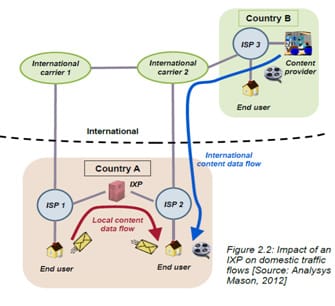Last month, the Philippine Senate conducted a hearing to investigate the reason behind the country’s slow and expensive internet connection. What prompted the probe was an infographic posted by ASEAN DNA on Facebook showing the Philippines in the bottom three Southeast Asian countries with the slowest average internet speed, based on an Ookla speed test. That post has since gone viral, especially among disgruntled Filipino netizens.
Local IP peering was one of the possible solutions mentioned at the hearing by no less than the regulator, the National Telecommunications Commission (NTC). Soon after, a number of articles on IP peering began making the rounds on social media. There was even a change.org petition urging PLDT, the incumbent telco and largest ISP, to do local IP peering.
Now what does this tell us? The demand for better internet service has reached such a critical point that even the ordinary customer is becoming interested in something as technical as IP peering.
How and why is peering important to getting faster and more affordable internet connection?
To help answer this, I had a chat with Wilson Chua, managing director and co-founder at Bitstop Network Services, Inc. Starting out in computer distribution, Bitstop next ventured into operating a franchise of paging service EasyCall and promoting Mozcom in the province of Pangasinan before branching out to call centers and data-center operations via BNShosting.net. Bitstop was the first local ISP to peer via the Philippine Open Internet Exchange (PHOpenIX), the only publicly funded, neutral, and non-profit internet exchange point in the country. Below, Chua responds to my questions on peering and how it is benefiting Philippine internet.
TA: Can you explain what local IP peering is and how it benefits an ISP like Bitstop?
Local peering happens when two or more network operators decide to “meet” each other at a common point (the internet exchange or IX). When peering, an operator agrees to let others use the interconnection link to pass traffic from its own network to another operator’s network, and vice versa. By doing so, both parties benefit from a reduction of bandwidth by using the cheaper direct links instead of the costly international circuits. Operators who peer also agree to not charge the other party for the traffic, so neither party pays for the exchanged traffic.
Local peering has several benefits:
- Faster access times. Our hosted clients benefit from having their sites connected directly to the local internet community in the Philippines via the shortest distance possible. This improved network performance is one of the main reasons for connecting to the IXP. In an illustration (below) from a reportby Analysys Mason and Internet Society, you can see that users of ISP1 can get to ISP2 via direct peering links (red line with arrow). Without this peering, ISP1 users will have to go out of the country, use the expensive international links, pass via another carrier, and then on to another ISP3, before getting back to the country to reach ISP2. The same process happens vice versa. This is inefficient and slow, and can burden international bandwidth resources.

- Resiliency. As the Philippines is located in the Ring of Fire and the Typhoon belt, we see that most carriers’ links are affected by earthquakes and storms from time to time. When some of these links go down, the IX can provide an alternative path for the traffic of various operators to pass to get to each other’s local network. Going back to the illustration, suppose ISP1’s link to International Carrier 1 (purple line) goes down (like in the case of the Taiwan earthquake). Without the peered links (red line), ISP1 users will not be able to talk to ISP2 users.
- Community relationships. Since the exchange puts system admins in regular contact with each other, we find it easier to form communities of interest and help each other out with common issues like security (e.g., hacking and cyber-attacks).
- Efficient marketplace for bandwidth. Some of the IXPs have evolved into a universal market place to buy bandwidth from other peered partners. Peered partners can buy from other peers with excess bandwidth capacity, for the former to fill up spikes in their traffic. This effectively provides a market-based mechanism for internet pricing—one that is not subject to “lockdowns” by current providers.
TA: When did you start peering? How did you find out about the PHOpenIX?
I was influenced by APNIC and Dr. William Norton, both of whom have been highlighting the power and benefits of peering exchanges since the 1990s. So from the early days, we were peered with PLDT’s PHIX. However, they price their local loop (last mile) so high such that all the other peered partners could only put in small links. This wasn’t enough to sustain the local community. Imagine a peering point with 2mbps links only. Later on, the Manila Internet eXchange (MIX) and BayanTel’s NIGX offered us a connection. We connected to these as well, but since they were telcos, I couldn’t see other telcos and ISPs connecting to these exchanges.
When I heard that the government was developing a neutral peering point, the PHOpenIX, I immediately signed up from day one. Since then, we have grown our link from a measly 512kbps to 50mbps today.
TA: What considerations did you take before deciding to peer via the PHOpenIX?
It had to be sustainable and had to have the potential of getting a critical mass of operators using it. Peering has what we call Network Efforts. As more networks are connected, the value of the peering point increases. As the Metcalf Law states, “The value of the telecommunications network is proportional to the square of the number of connected users of the system.” I think the PHOpenIX is about to reach that critical mass of users with news of more operators coming in and peering.
Source: http://www.telecomasia.net/blog/content/peer-or-not-peer-conversation-bitstopph



